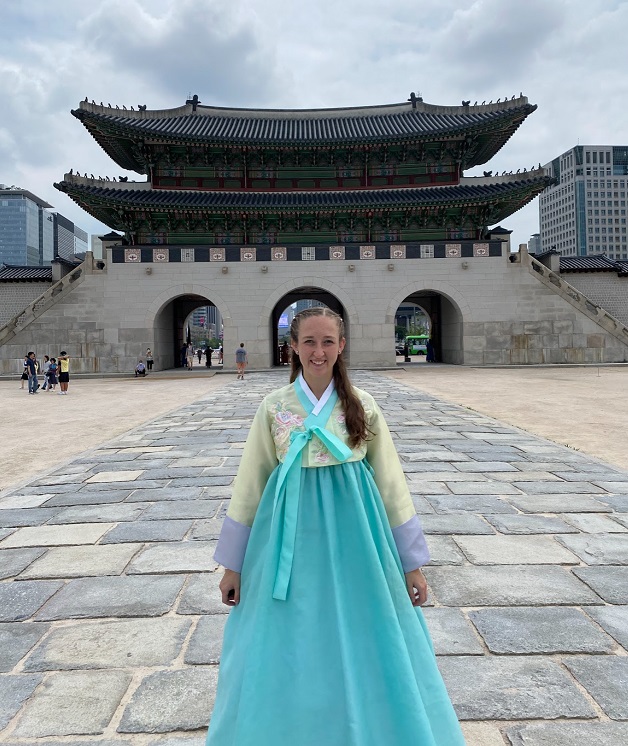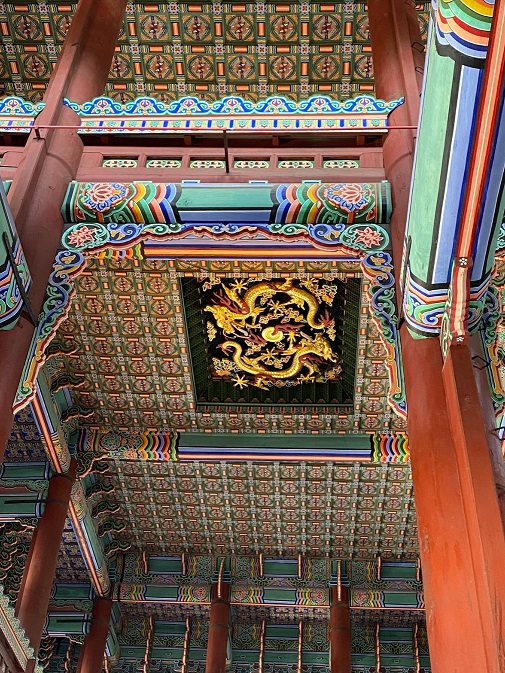경복궁 (Gyeong bok gung) is the largest palace built by Korea’s last dynasty, the 조선 (Joseon) dynasty, which ruled Korea from 1392 all the way until 1910 when the Japanese took over. The palace lies in front of Mount Bugak and so the architectural style it was built in was designed to be in harmony with the natural landscape. Today, the palace is open to the public as a museum, a token remembering Korea’s dynastic tradition and history. 경복궁 is located in the middle of Seoul, so the ancient, Korean-style architecture sits side by side with Seoul’s modern skyscrapers. Fun fact from my Modern Korean History class: 경복궁 was the first place to get electricity in Korea!

During the 조선 dynasty, the traditional style of clothing was called 한복 (han bok); 한복 is a beautiful, intricately woven garment that is very conservative, including wide long sleeves and a dress that covers the ankles for both men and women. Today, Korean people don’t wear 한복 anymore besides two exceptions: for special occasions and at 경복궁. If you wear 한복 to the palace, then you can get into 경복궁 for free, and so the streets surrounding the palace are filled with 한복 rental shops and many people, Koreans and foreigners alike, dressed in 한복.
So myself and a couple other girls from Yonsei found a 한복 rental shop where we picked out and donned beautiful, traditional 한복 pieces and got our hair braided with pearls. As we walked through the massive gates to see the palace containing the king’s throne above, we stepped into another time. I felt like a queen.
The main walkway up to the throne is divided into three side-by-side paths: the middle and biggest path for the king, the right path for the civil officials, and the left path for the military officials. We followed these paths up the stairs to get a glimpse inside the throne room where all the walls and even the ceiling are so intricately painted. In the center of the ceiling, there are two golden dragons circling each other, both with five claws on each hand. According to ancient Asian dynasties, especially those in China, each claw represented power, so more claws meant more power. Typically, the thrones of Asian royal dynasties depicted dragons with four claws though; a five-clawed dragon is a true rarity and symbolizes great power.

Behind the palace was a village of buildings made all in the same intricate style. These were once administrative buildings, living quarters for the royal family, and education centers. There was so much to learn here, especially about the last king of the 조선 dynasty, Emperor Kojong, and his family, particularly about his wife Queen Min. Queen Min was very involved in the politics and government of Emperor Kojong’s reign, so much so that Japan saw her as a threat to their imperialization. Since Queen Min stood in the way of Japan’s annexation of Korea, the Japanese assassinated her and with her, the 조선 dynasty crumbled.

As we were leaving 경복궁, there were some Korean high school students also dressed in 한복 who asked us if we would like to join them in performing 강강술래 (gahng gahng sool rae). 강강술래 is a traditional folk dance that women performed during the holiday 추석 (chu seok) which is similar to Thanksgiving. This dance was a prayer for a fruitful harvest where women gathered together under the full moon, made a circle, and held each other’s hands while singing and rotating clockwise. The speed of the dance typically increased as it went along and sometimes the dance even lasted until dawn.
https://drive.google.com/file/d/1aQSqc5lXfL-6j9BZrI_ipS3cLrRmym_B/view?usp=sharing
Even though our dance did not last until morning, exploring the palace and dancing the 강강술래 while wearing 한복 has been my favorite experience in Korea so far. Truly experiencing this ancient history of Korean culture brings what I’ve been learning in my Korean classes at Notre Dame and my Modern Korean History class here at Yonsei to life.
